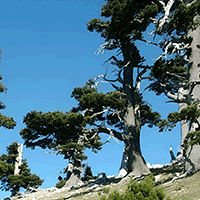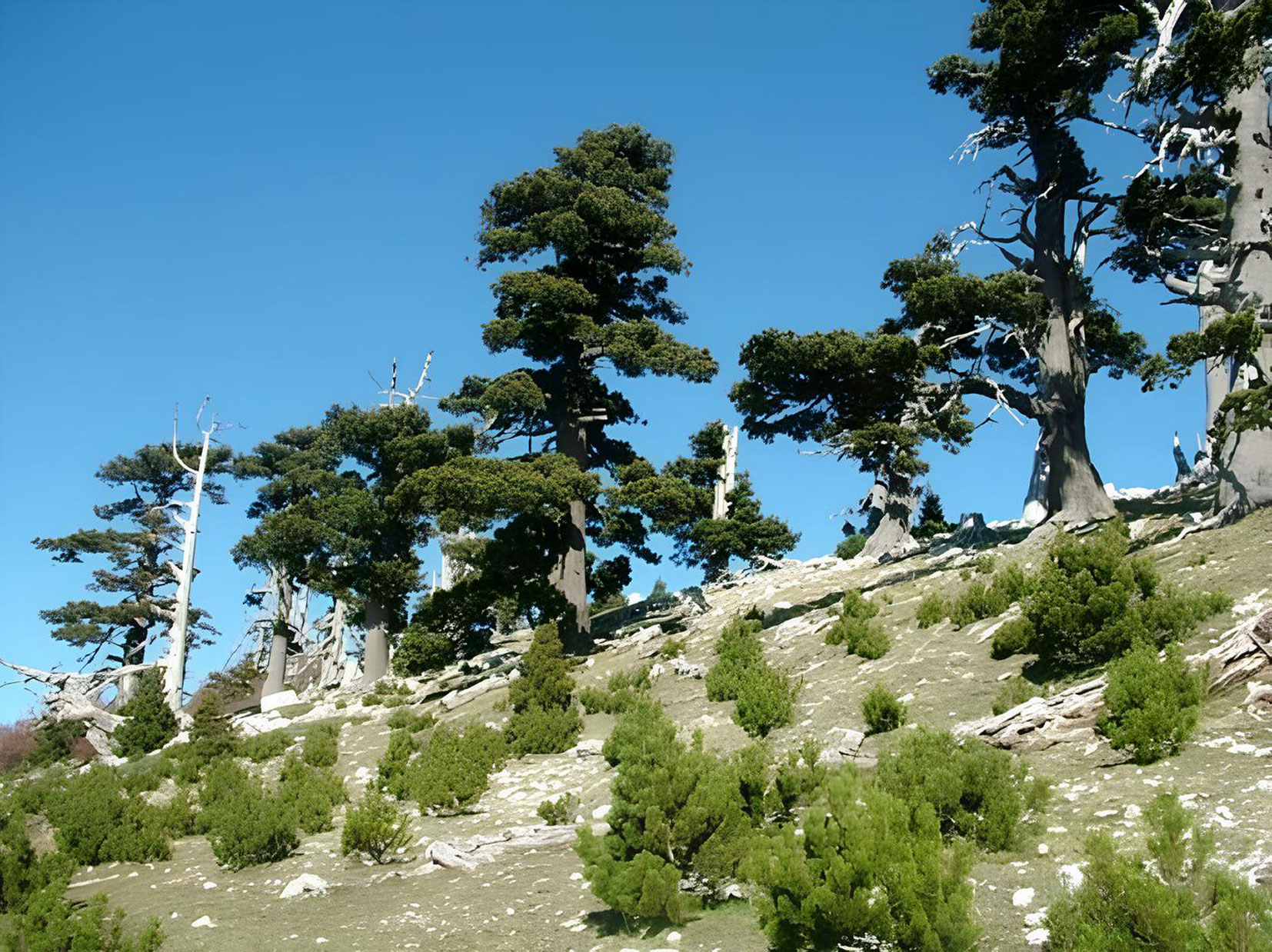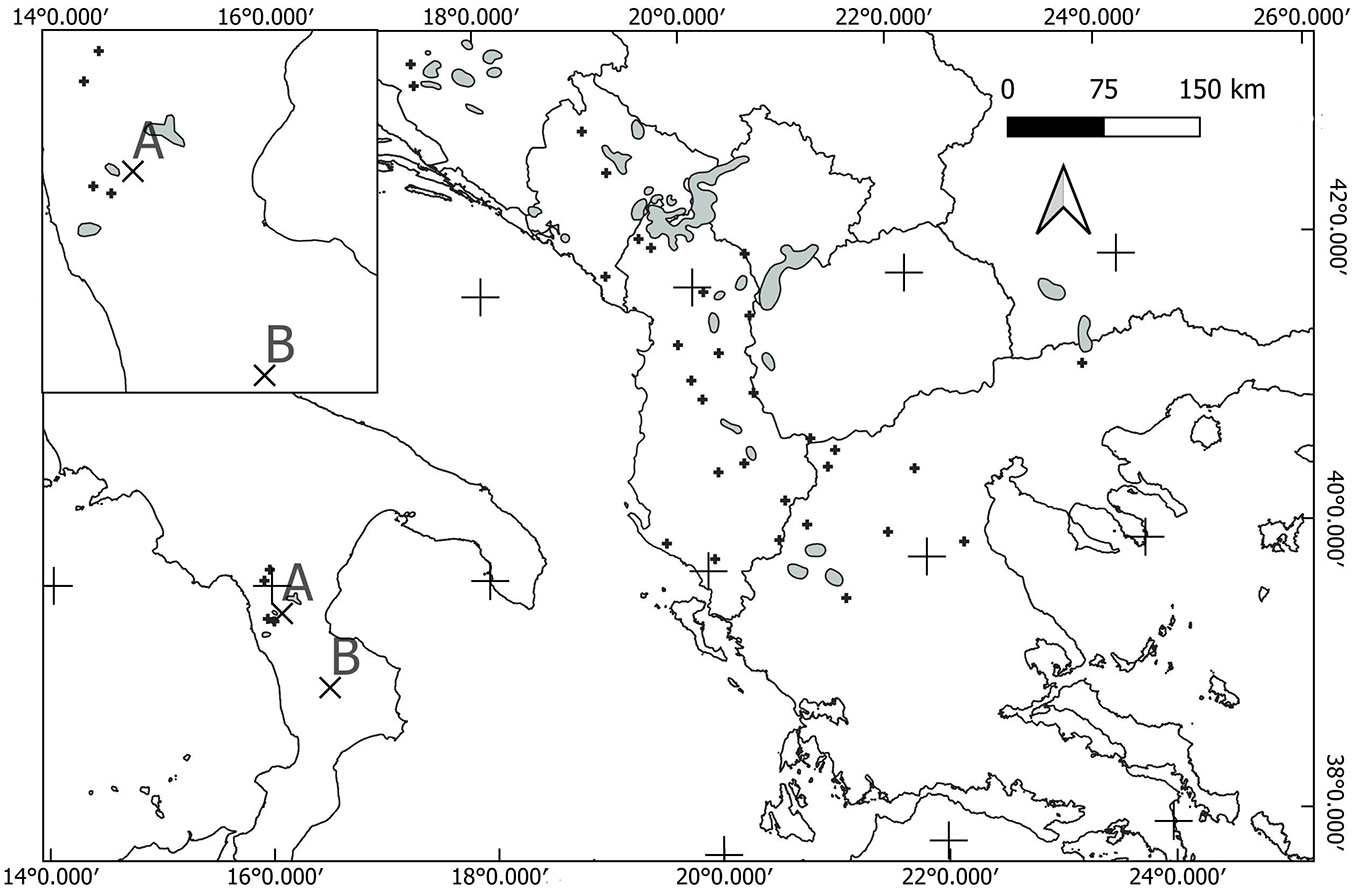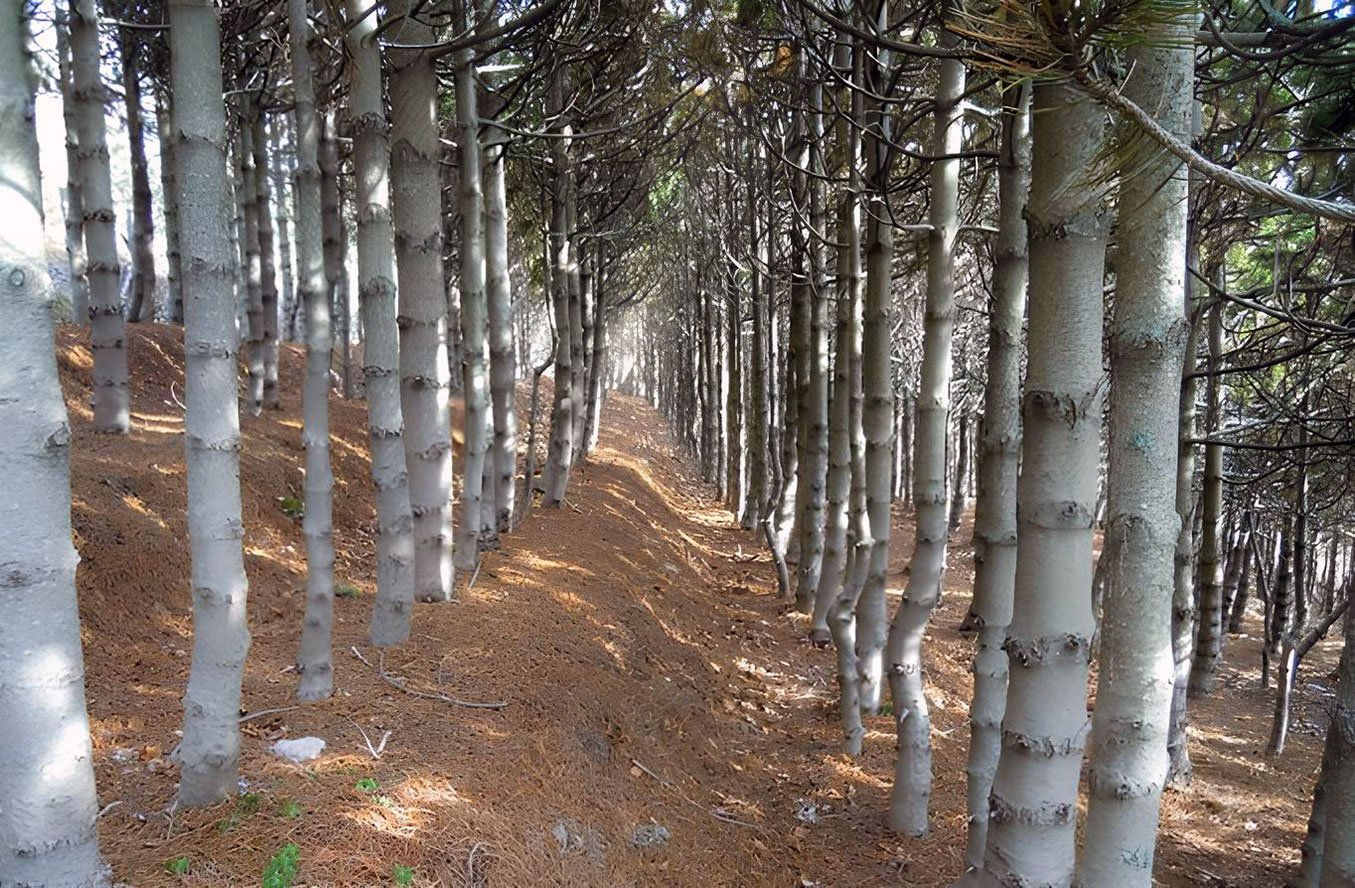
Experimental reforestation with Bosnian pine under Mediterranean mountain conditions
iForest - Biogeosciences and Forestry, Volume 17, Issue 5, Pages 331-337 (2024)
doi: https://doi.org/10.3832/ifor4635-017
Published: Oct 19, 2024 - Copyright © 2024 SISEF
Research Articles
Abstract
The Bosnian pine is a relict species of the Tertiary Oro-Mediterranean forests, with a distribution mainly extended over the Balkan peninsula and disjunct Italian populations on the mountain ranges between the regions of Basilicata and Calabria. The ability to adapt to harsh climatic conditions, to survive in difficult environments and the wide altitudinal range where it is possible to find natural populations are the main reasons this species has been considered in planning reforestation interventions. This study compares growth and survival performances in two experimental plots of Bosnian pine reforestations established on different pedogenic substrates (Mesozoic limestone rocks vs. Paleozoic granites) of the mountains of Calabria using different types of propagation material (bare-root vs. containerized seedlings). At an age of approximately 40 years, annual increments in the two experimental plots averaged over the last two decades were equal to 0.2 cm and 0.1 cm, 0.2 m and 0.3 m, 8.4 m3 ha-1 and 7.3 m3 ha-1 for diameter, height and volume, respectively. These results confirm the ability of the species to successfully cope with the edaphic poverty of the outcropping rocky substrates and the rigidity of the climatic factors that characterize Mediterranean mountains; the growth performances are somewhat unexpected, higher than the average ones registered in Italy for black pine forests. Operationally, the production system of bare-root seedlings does not guarantee the best results under the examined conditions. This study contributes to improving the potential use of the species for new reforestation and related nursery activities, necessary for in-situ and ex-situ conservation.
Keywords
Pinus leucodermis, Forest Restoration, Forest Reproductive Material, Bare-root Seedlings, Containerized Seedlings
Introduction
In recent years, the ongoing climate changes have led to an increase in studies concerning forest species growing at the upper altitudinal limits of the forest (treeline) or which demonstrate good adaptability to harsh pedoclimatic conditions ([6], [40]). The variation in climatic conditions with increasing altitude (e.g., precipitation and average temperatures change between years, seasonal temperature and predominant winds variability) is a contributing factor to the altitudinal distribution of tree species ([38]). Among these, the Bosnian pine (Pinus leucodermis Antoine = Pinus heldreichii subsp. leucodermis Antoine A.E. Murray) is of particular interest, a relict species of the Tertiary Oro-Mediterranean forests (coniferous forests of the Mediterranean, Anatolian and Macaronesian regions, under the European Forest Types classification - [5]), whose main range extends over the Balkan peninsula with four natural disjoined populations in southern Italy between the regions of Basilicata and Calabria. Genetic studies have clarified the relationships between the Balkan populations and the Italian ones, which are considered fragmented populations of the same biological species ([9]).
The Italian populations are represented by two Apennine stands (Alpi-Spina-Zàccana, Pollino) and two coastal ones (Palanuda-Pellegrino, Montéa), characterized by altitudes ranging from 530 m a.s.l. of the Cavaiu Canal of the Argentino River up to 2240 m a.s.l. of the northern Anticima of Serra Dolcedorme in the Pollino Massif, for a total of approximately 5700 ha, of which 50% on the Pollino, 38% in the coastal sectors and 12% in the Lucanian mountain groups ([3], [4]). In its Italian natural range, the Bosnian pine is therefore characterized by wide plasticity and adaptability along the elevation gradient.
In recent decades, various research on Bosnian pine has concerned dendroecology applied to investigations in growth-climate relationship ([27], [33], [34]); high mountain ecosystems are among the most sensitive to such changes, therefore forest stands that grow at the upper altitudinal limits are of particular interest for evaluating the variation of climatic factors and the effect of extreme climatic events on trees. A reduction of Bosnian pine growth during the second half of the 20th century due to temperature rise and rainfall decrease shows the necessity to investigate the potential impacts of climate warming on species growing near the tree-line ([7]), though tree-ring formation in this pine seems not to depend on a single dominant factor, but rather on various combinations of summer precipitation and temperature ([35]).
Bosnian pine is a species characterized by very high longevity ([28]) and ability to survive in high-altitude environments, which can represent a reliable archive for documenting climate changes, especially in geographical areas where direct measurements of temperature and precipitation are not available or where records are limited to short or fragmentary time periods. The species reflects well interannual- to decadal-scale summer temperature fluctuations in the Balkans ([39]), summer moisture availability ([21]), as well as temperature and precipitation variability on different high-altitude site exposition ([22]).
On the one hand, at the upper treeline between Basilicata and Calabria with relatively high temperatures and precipitation higher than 1200 mm year-1, the Bosnian pine has benefited in terms of survival and growth with respect to other forest tree species, but grazing and other human impacts (primarily timber harvesting and agricultural activities) would indicate a negative influence on its possible expansion, highlighting the need for interventions of protection of older stands and forest restoration ([37]). On the other hand, recent studies on the dynamic aspects of such populations of Bosnian pine have highlighted substantially stable formations in the steep areas with outcropping rocks ([24]) where this pine prevails over other species thanks to particular ecophysiological adaptations ([19]), and even formations expanding in open areas where the species shows its colonizing ability (Fig. 1). Given the positive response to reforestation in Mediterranean mountains ([32]), employing this pine seems to be a viable option for forest restoration purposes.
Fig. 1 - Over one-hundred-year-old Bosnian pines with natural regeneration in the natural population of Serra di Crispo (2053 m a.s.l.) on the Pollino massif (by courtesy of S. Avolio).
Actually, the ability to survive in and adapt to environmental conditions of Mediterranean mountains characterized by weather extremes with soil degradation interactions and the wide altitudinal range where natural formations of Bosnian pine can be found, have brought out the interest in this species in the planning phase of the reforestation interventions carried out between Basilicata and Calabria during the last century. The first pilot reforestations, located at altitudes between 1100 and 1700 m a.s.l., date back to the end of the 1950s ([3]) and were carried out with soil preparation by terraces and pitches, where 2-year-old seedlings produced with seeds originating from this geographical area (in particular, from the Pollino and Montèa mountains) were planted. The encouraging results obtained have brought the Regional Bodies in charge of forestation to expand the reforested areas using this species in the following decades, although the overall extension can be currently estimated at no more than 100 ha. The younger reforestations further confirmed the good results already obtained by the older ones as well as the high survival and the ability of the Bosnian pine to be established on poorly developed soils.
After the studies by Avolio ([4]), no reference on reforestation with this species can be found in Italian literature and even at an international level the literature on the subject is very scarce. In light of this, the objective of this work was to compare the growth and survival between two experimental plots within Bosnian pine reforestations established in Calabria on the Coastal Range and on the Sila Plateau, characterized by pedogenic substrates made up, respectively, of Mesozoic limestone rocks and Paleozoic granites. The second objective was to compare growth and survival of different types of propagation material (bare-root vs. containerized seedlings) in the experimental plot of the Sila Plateau. This information can contribute to improve the potential use of the species for new reforestation and related nursery activities in Mediterranean mountain ecosystems, being forests a fundamental protective element of the landscape against anthropogenic and climatic-induced threats.
Materials and methods
Study areas
The study focused on two experimental plantations established in the autumn of 1982 (Coastal Range) and in the winter of 1984 (Sila Plateau) by the former Italian Experimental Institute for Silviculture, now the Research Centre for Forestry and Wood of the Council for Agricultural Research and Economics (CREA). Bosnian pine 2-year-old seedlings (1251 and 624 plants in the two sites, respectively), both as containerized (phytocell) and bare-root material produced by the Tardo forest nursery of Campotenese, were planted in holes at variable spacing, with a planting density of 5353 and 5114 seedlings ha-1 in the two sites, respectively.
The reforestation on the Coastal Range is located in the Caramolo area of the Municipality of Saracena (Fig. 2), in the territory of the Pollino National Park (WGS84 coordinates: 39° 48′ 15″ N, 16° 05′ 23″ E), at an altitude of 1550 m a.s.l. on a slope of 35 percent with S-SW exposure. The monitored experimental plot has a rectangular shape and an area of 2340 m2, within which the seedlings of Bosnian pine were planted in holes on terraces (Fig. 3).
Fig. 2 - Geographical location of the study areas (A - Caramolo, B - Pietra dell’Altare) with Bosnian pine whole distribution ([11]) and detail of the Italian populations.
The reforestation on the Sila Plateau is located in the Pietra dell’Altare area of the Municipality of Casali del Manco (Fig. 2), in the territory of the Sila National Park (WGS84 coordinates: 39° 16′ 34″ N, 16° 30′ 58″ E), at an altitude of 1680 m a.s.l. on flat ground. Under the forest landscape of the Sila Plateau, characterized by the dominance of the Calabrian pine (Pinus nigra Arn. ssp. laricio Poiret), this reforestation was aimed at contributing to the knowledge on the potential of the Bosnian pine to adapt to different soils compared to the predominantly calcareous ones typical of its natural range in Italy. The experimental plot has a rectangular shape and an area of 1220 m2, within which the seedlings of Bosnian pine (half from containerized material and half with bare-roots) were planted in holes in rows by dividing the treatments in two separated subplots of about 600 m2 at the same plant density of 312 seedlings in each subplot (Fig. 4).
Fig. 4 - View of pine trees (age: 39 years) at the experimental plot of Pietra dell’Altare (Sila Plateau).
Environmental features
For the study area of the Coastal Range, the reference meteorological station is located in Campotenese (965 m a.s.l., about 7 km away), indicating a temperate sub-mountain Mediterranean climate type with hot and dry summers (during which afternoon storms are, however, not rare) and humid and rainy winters characterized by heavy snowfall. The average annual temperature is 10.3 °C, that of the coldest month (January) 1.1 °C and that of the hottest month (August) 19.1 °C. The average annual precipitation is 1425 mm, with a minimum of 30 mm in July and a maximum of 212 mm in December ([1]). The soil derives from a substrate made up of dolomitic limestone formations, the evolution of which is linked to the slow dissolution of the limestone rock due to the action of the carbonic acid dissolved by the water and the accumulation of insoluble residues; from a taxonomic point of view they can be classified as Lithic Hapludolls of the USDA Soil Taxonomy characterized by an udic humidity regime and with lithic contact with the parent rock 50 cm under the surface ([2]).
The climate of the study area on the Sila Plateau can also be classified as temperate Mediterranean. According to the meteorological station of Camigliatello Monte Curcio (1730 m a.s.l., about 9 km away) the average annual temperature is 7.7 °C, that of the coldest month (January) 0.2 °C and that of the hottest month (August) 16.2 °C. The average annual rainfall is 1242 mm, with a minimum of 34 mm in July and a maximum of 180 mm in November ([1]). The soil is characterized by slightly acidic reaction, moderate depth and high permeability and derives from a substrate made of highly altered granitic rocks classified within the Dystrudepts of the USDA Soil Taxonomy; also in this case the udic pedoclimatic regime predominantly directs the pedogenetic development ([2]).
Dendrometric surveys
Dendrometric data were recorded in 2009 and 2023 in the experimental plot of the Coastal Range and in 2003 and 2023 in that of the Sila Plateau. The survey involved counting all the living and dead trees and measuring their diameter at breast height (DBH), and total height (H) on a random sample of approximately 40% of the trees. Tree volume was estimated by the two-way volume equation established by Tabacchi et al. ([36]) for small conifer trees for the Italian national forest inventory, expressed as follows (eqn. 1):
The equation refers to volume (stem and branch wood with diameter > 5 cm, V) of small conifer trees in relation to breast height diameter (d, cm) and height (h, m) of trees, where b1 = 2.1414 and b2 = 3.4917 · 10-2.
Results
The summary of the dendrometric data collected in the two surveys is shown in Fig. 5. For the Coastal Range plot, quadratic mean diameter (DBHq) of 9.3 cm in 2009 and 12.2 cm in 2023 was recorded, with an average annual increment of 0.2 cm over this period; the average annual height increment was 0.23 m. Stand volume of living trees per hectare was equal to 68 m3 in 2009 and 185 m3 in 2023, with an average annual increment of 8.4 m3 over the period. The mortality rate recorded in 2023 was equal to 8.4%. For the Sila plot, DBHq was 15.9 cm in 2003 and 17.9 cm in 2023, with an average annual increment of 0.1 cm over this period, while the average annual height increment was 0.28 m. Stand volume of living trees per hectare was equal to 254 m3 in 2003 and 400 m3 in 2023, with an average annual increment of 7.3 m3. The mortality rate found in 2023 was 29.5%. The comparison of the mean annual increment of stand volume of living trees (4.5 m3 ha-1 for the plot of the Coastal Range and 6.5 m3ha-1 for the plot of the Sila Plateau) with the current annual increment data mentioned above testifies that the growth potential of both stands has not yet reached its maximum average value.
Fig. 5 - Experimental plots of Bosnian pine in the Caramolo (Coastal Range) and the Pietra dell’Altare (Sila Plateau) areas (survey years: 2009 and 2023, 2003 and 2023 respectively); living and dead trees (since planting, in autumn 1982 and winter 1984, respectively) and dendrometric data. (DBHq): quadratic mean diameter; (Hq): mean height and stand volume refer to living trees.
For the experimental plot of the Sila Plateau the summary on the performance of trees from bare-root vs. containerized seedlings is shown in Fig. 6. Analysis of variance (ANOVA) was performed to test for differences in growth performance of bare-root vs. containerized seedlings, considering DBH and H recorded in the two surveys of 2003 and 2023. For all variable-year combinations, the ANOVA results showed significant differences (p<0.01) between containerized and bare-root seedlings (Tab. 1). The sample sizes are sufficiently large to assume the asymptotic normality and the homoscedasticity of the observations. However, as a further validation, the non-parametric Kruskal Wallis test was applied; also in this case, for the two variables considered (DBH and H), the test confirmed the results obtained by ANOVA, with very low p-values.
Fig. 6 - Comparison of the performance of trees from bare-root seedlings vs. containerized seedlings in the experimental plot of Pietra dell’Altare (Sila Plateau), survey years 2003 and 2023; living and dead trees (since planting, in winter 1984) and dendrometric data. (DBHq): quadratic mean diameter; (Hq): mean height and stand volume refer to living trees.
Tab. 1 - ANOVA of DBH and H of trees for bare-root vs. containerized seedlings in the experimental plot of the Sila Plateau. (df): degrees of freedom; (SS): sum of squares; (MS): mean square.
| Variable | Year | Type | df | SS | MS | F | p-value |
|---|---|---|---|---|---|---|---|
| Stem diameter | 2003 | Bare-root/Container | 1 | 4042 | 4042 | 119 | <0.01 |
| Residuals | 554 | 11314 | 20 | ||||
| 2023 | Bare-root/Container | 1 | 2527 | 2527 | 116 | <0.01 | |
| Residuals | 389 | 8440 | 21.7 | ||||
| Stem height | 2003 | Bare-root/Container | 1 | 45.3 | 45.3 | 84 | <0.01 |
| Residuals | 237 | 128.4 | 0.54 | ||||
| 2023 | Bare root/Container | 1 | 93.6 | 93.6 | 9 | <0.01 | |
| Residuals | 147 | 1551 | 10.6 |
Discussion and conclusions
The effects of ongoing climate change can influence forest ecosystems, for example as regards their multifunctionality, variation in the species composition, altitudinal and latitudinal shifts, loss of biodiversity and decreased productivity. The research issue is whether forests will be able to react to these changes, or whether human intervention will favor the spreading of tree species with greater adaptability and resilience at the treeline ([29], [10]).
The Bosnian pine is sometimes believed to expand at high altitudes in the beech forests between Calabria and Basilicata due to climate change which seems to penalize beech ([24]). In constrast, the dynamics observed in the field ([40]) indicate that Bosnian pine is colonizing the secondary grasslands of the Alpine belt, above 1900-2100 m a.s.l. on the Pollino massif (Mount Pollino, Dolcedorme, Serra del Prete, etc.). Indeed, the subalpine belt is dominated by multi-stem beech stands with very high density, where the pine colonization seems absent ([31]) and microclimatic conditions for germination, recruitment and establishments of pine saplings are unfavourable ([30]).
There is still relatively little knowledge on the biogeography and population dynamics of the species, to identify correct conservation strategies and evaluate the impact of climate change. However, the fairly high self-pollination rates found in the early stages of development indicate a possible strategy of adaptive significance for a pioneer species ([25], [26]).
In this study, the growth trends in tree diameter, height and stand volume confirm the ability of this species to successfully cope with shallow soils of the outcropping rocky substrates and the rigidity of the climatic factors characterizing Mediterranean mountains, with unexpectedly higher performances than the average values recorded in Italy for black pine forests by the National Forest Inventory ([15]). The small differences in performance between the two plots suggest similar adaptation capabilities to the very different pedological and geomorphological characteristics of both study areas. Furthermore, the comparison between the mean annual increment and the current annual increment of stand volume of living trees indicates that, at about 40 years of age, the growth potential of the examined stands has not reached its maximum average value yet, and this further confirms the interest of using Bosnian pine in environments similar to those considered in the present study.
As regards the forest reproductive material employed in the experimental plot of Sila, a constant mortality rate for 2-year-old bare-root seedlings was recorded during the experimental period (approximately 16% both between the planting and the year 2003 and between 2003 and 2023), while for seedlings grown in containers a higher mortality (about 42%) was recorded in the period 2003-2023 than in the period between planting and 2003 (about 6.4%). It could be hypothesized that the initial higher percentage of survival of containerized seedlings might have led to greater intraspecific competition over time, thus raising the subsequent mortality. However, trees grown in containers were characterized in 2023 by higher values in terms of stem diameter and stand volume compared to those obtained by bare root propagated material, showing that a greater mortality could be counterbalanced by an overall better growth performance in some stand parameters.
Various studies have examined nursery production by comparing containerized vs. bare-root seedlings, though any unambiguous conclusions have been reached ([23], [16], [18]). Based on our results, we can suggest that for Bosnian pine plantations in open areas of the upper mountain Mediterranean areas, characterized by high-altitude climates and poor soils, the production system of bare root material does not guarantee the best results and containerized seedlings should be preferred if reforestation objectives are more focused on growth performances of trees over time than on survival of plant material.
The traditional basic containers (phytocells) used in nurseries for many decades in Mediterranean countries have now been abandoned in favor of more performing ones, capable of guaranteeing more suitable development of the root system, especially in the case of pines ([20]), though a more efficient containerized production system is expected today for forest nurseries. In general, growing seedlings in containers allows for suitable operating conditions for the use of the reproductive material (transport, planting, rooting), particularly in difficult environmental conditions, for better resistance to aridity, even if less development of the epigeous part of the tree is expected in nursey ([17]). In this sense, the results of this study indicate both a good survival of the containerized seedlings after planting and good growth performance even in the long run, despite the fact the containers used in the examined reforestation were rudimentary (phytocells).
The difficult conditions of reforestation in the Mediterranean mountainous area are exacerbated by climate change with the reduction of summer rainfall. Nonetheless, the results of this study help understand the importance of using suitable forest reproductive material in overcoming the years following plantation and developing good growth performances later. This knowledge can improve ex situ and in situ conservation measures, especially at the limits of the natural altitudinal range of the species, while climate change may affect the regeneration of natural populations by reducing germination of seeds and seedling recruitment ([12]).
The positive effect of stratification on germination of Bosnian pine seeds, which is stronger in those collected at higher altitudes ([8]), indicates the importance of dormancy for the development of seedlings in difficult environmental conditions of the treeline and, therefore, the need to organize forest nursery activities consistently with the ecophysiological characteristics of the species. Furthermore, to date there are no Basic Materials (BM) for Bosnian pine in the Italian national register, while at European level only five BM are registered ([14]). Greater attention by the forest nursery sector to this species, and in general to forest species with fragmented distribution and/or at the limits of their range in the Mediterranean area ([13]), necessarily involves the identification of a sufficient number of BM as seed sources for future reforestation activities, ensuring adequate genetic diversity.
Acknowledgements
This work has been carried out as a part of the activities funded by the Rete Rurale Nazionale (the Italian National Rural Network of the Ministry of Agriculture, Food Sovereignty and Forests) - WP 22.2 “Foreste”.
We thank Silvano Avolio for making available the older data on the examined experimental plots and Carlo Di Marco for his technical assistance.
References
Gscholar
Gscholar
CrossRef | Gscholar
Gscholar
CrossRef | Gscholar
Gscholar
Gscholar
Gscholar
Authors’ Info
Authors’ Affiliation
Giuseppe Pignatti 0000-0002-3947-0160
Research centre for Forestry and Wood, Council for Agricultural Research and Economics - CREA, Via Valle della Quistione 27, I-00166 Roma (Italy)
Innocenzo Muzzalupo 0000-0002-0264-1392
Rosario Turco 0000-0001-8156-7831
Kevin Garofalo 0009-0006-8759-1449
Research centre for Forestry and Wood, Council for Agricultural Research and Economics - CREA, Contrada Li Rocchi Vermicelli 83, I-87036 Rende, CS (Italy)
Corresponding author
Paper Info
Citation
Corona P, Bernardini V, Muzzalupo I, Turco R, Garofalo K, Pignatti G (2024). Experimental reforestation with Bosnian pine under Mediterranean mountain conditions. iForest 17: 331-337. - doi: 10.3832/ifor4635-017
Academic Editor
Marco Borghetti
Paper history
Received: May 04, 2024
Accepted: Aug 18, 2024
First online: Oct 19, 2024
Publication Date: Oct 31, 2024
Publication Time: 2.07 months
Copyright Information
© SISEF - The Italian Society of Silviculture and Forest Ecology 2024
Open Access
This article is distributed under the terms of the Creative Commons Attribution-Non Commercial 4.0 International (https://creativecommons.org/licenses/by-nc/4.0/), which permits unrestricted use, distribution, and reproduction in any medium, provided you give appropriate credit to the original author(s) and the source, provide a link to the Creative Commons license, and indicate if changes were made.
Web Metrics
Breakdown by View Type
Article Usage
Total Article Views: 5575
(from publication date up to now)
Breakdown by View Type
HTML Page Views: 3624
Abstract Page Views: 851
PDF Downloads: 921
Citation/Reference Downloads: 3
XML Downloads: 176
Web Metrics
Days since publication: 424
Overall contacts: 5575
Avg. contacts per week: 92.04
Article Citations
Article citations are based on data periodically collected from the Clarivate Web of Science web site
(last update: Mar 2025)
(No citations were found up to date. Please come back later)
Publication Metrics
by Dimensions ©
Articles citing this article
List of the papers citing this article based on CrossRef Cited-by.
Related Contents
iForest Similar Articles
Research Articles
Forest litter as the mulch improving growth and ectomycorrhizal diversity of bare-root Scots pine (Pinus sylvestris) seedlings
vol. 8, pp. 394-400 (online: 20 August 2014)
Review Papers
Genetic diversity and forest reproductive material - from seed source selection to planting
vol. 9, pp. 801-812 (online: 13 June 2016)
Research Articles
Size and age: intrinsic confounding factors affecting the responses to a water deficit in black spruce seedlings
vol. 8, pp. 401-409 (online: 09 December 2014)
Research Articles
Carbohydrate metabolism during new root growth in transplanted Larix olgensis seedlings: post-transplant response to nursery-applied inorganic fertilizer and organic amendment
vol. 10, pp. 15-22 (online: 22 September 2016)
Research Articles
Controlled-release fertilizers combined with Pseudomonas fluorescens rhizobacteria inoculum improve growth in Pinus halepensis seedlings
vol. 8, pp. 12-18 (online: 12 May 2014)
Research Articles
Substrates and nutrient addition rates affect morphology and physiology of Pinus leiophylla seedlings in the nursery stage
vol. 10, pp. 115-120 (online: 02 October 2016)
Research Articles
Effects of substrate and ectomycorrhizal inoculation on the development of two-years-old container-grown Norway spruce (Picea abies Karst.) seedlings
vol. 8, pp. 487-496 (online: 10 November 2014)
Short Communications
Differential adaptations in nursery seedlings from diverse Chilean provenances of Peumus boldus Mol.
vol. 9, pp. 409-413 (online: 29 January 2016)
Review Papers
Should the silviculture of Aleppo pine (Pinus halepensis Mill.) stands in northern Africa be oriented towards wood or seed and cone production? Diagnosis and current potentiality
vol. 12, pp. 297-305 (online: 27 May 2019)
Research Articles
Use of alternative containers for promoting deep rooting of native forest species used for dryland restoration: the case of Acacia caven
vol. 10, pp. 776-782 (online: 02 September 2017)
iForest Database Search
Search By Author
Search By Keyword
Google Scholar Search
Citing Articles
Search By Author
Search By Keywords
PubMed Search
Search By Author
Search By Keyword















